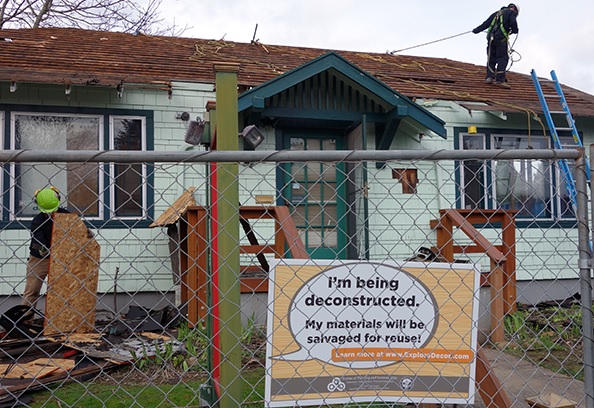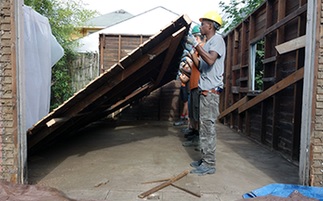
Portland is leading the country by requiring deconstruction of historic homes which are already planned for demolition. Any one or two family structure that was built before 1917 or is a designated historic resource will require a full manual deconstruction rather than mechanical demolition starting on October 31st of this year.
Measures to address residential demolition waste have been discussed since April 2015 when the Deconstruction Advisory Group (DAG) was convened to recommend a new policy for managed deconstruction in the midst of Portland’s demolition epidemic. Restore Oregon was one of 16 representatives which participated in DAG and played a vital role in the development and implementation of policies regarding deconstruction for the city.
In February, the Bureau of Planning and Sustainability (BPS), with the recommendations of DAG, presented a resolution to the City Council regarding the deconstruction mandate and it was unanimously approved by Council. Since then, BPS has been working on the finalization of code language that will go into effect in October. Testimony was heard on June 29 at City Council and the code language approved on July 6.
Council also considered code language around deconstruction workforce development. This program will provide training and certification for the deconstruction of residential housing built before 1917 and encourages women, people of color, and underrepresented individuals to become certified. The program is projected to create new jobs and divert 8 million pounds of materials for reuse. Presently, a quarter of all of Portland metro’s landfill is due to the material produced from the demolition of homes. Less than ten percent of homes are deconstructed.

Last year, over 300 residential properties were demolished in the city of Portland. A third of this demolished housing stock was built before 1917. Using this data, the City projects that annually there will be 100 homes required to be deconstructed when the ordinance takes effect.
While some members of the public advocated for a later year, such as 1978 when lead paint was banned, BPS will be required to check in with City Council within 6 to 12 months to determine whether to modify, maintain, or expand the program. Currently, there are no companies that are certified by the city to provide deconstruction services, but BPS is optimistic that qualified professionals will enter the workforce as the market demands. There will be an all-day training on July 18th for any company wishing to become certified and BPS is projecting 12-15 companies will meet the city’s standards after this training session.
Much of the argument against manual deconstruction rather than mechanical demolition are related to the cost and time. A house that is 2,500 square feet in size would cost approximately $10,000 to demolish with traditional methods, while a more careful deconstruction would cost between $16,000 and $17,000. During the testimony on June 29, Mayor Charlie Hales observed that deconstruction is worth the time and cost. “I want it to be time-consuming, difficult, and expensive when we are throwing away 100 years of history,” said Mayor Hales.

